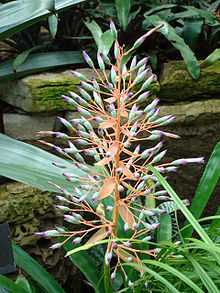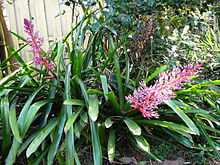Portea petropolitana
| Portea petropolitana | |
|---|---|
 | |
| Scientific classification | |
| Kingdom: | Plantae |
| (unranked): | Angiosperms |
| (unranked): | Monocots |
| (unranked): | Commelinids |
| Order: | Poales |
| Family: | Bromeliaceae |
| Subfamily: | Bromelioideae |
| Genus: | Portea |
| Species: | P. petropolitana |
| Binomial name | |
| Portea petropolitana (Wawra) Mez | |
| Varieties | |
| |
Portea petropolitana is a plant species of Portea in the botanical family Bromeliaceae that is endemic to Brazil.
Description
There are two varieties of Portea Petropolitana that are commonly found in cultivation. Variety petropolitana is found growing in Espirito Santo near the ocean. It may reach a height of 3 to 4 feet prior to flowering. The dark green leaves are heavily spined and form a stiff rosette. The inflorescence reaches 12 to 18 inches long, bearing colorful flowers with white lavender petals and orange sepals.[1]

Variety extensa was introduced by American plant collector and breeder M. B. Foster from Espirito Santo in Brazil. It is smaller in all parts compared to the other variety.[2] It is characterized by light yellow green leaves and a coral red inflorescence with an upright rosette. The flower contains lavender petals, apple green overies, and berries that turn dark purple.[3]
References
- ↑ Padilla, Victoria (1973). Bromeliads. New York: Crown Publishers. p. 60. ISBN 0517562413.
- ↑ Rauh, Werner (1979). Bromeliads For Home, Garden and Greenhouses. Nlandford Press Ltd. p. 349. ISBN 071370845X.
- ↑ Padilla, Victoria (1973). Bromeliads. New York: Crown Publishers. p. 61. ISBN 0517562413.